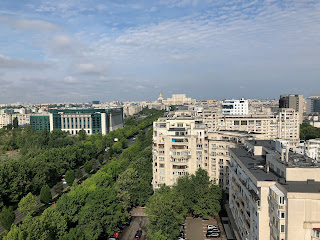The flight from Heathrow to Bucarest is under 3 hours. Otopeni is a modern airport and there to meet us was our guide - Tudor. He turned out to be superb. The afternoon drive from Bucarest to Transylvania and our hotel in the ski resort of Poiana Brasov was through pasturelands and forest on good roads. Our hotel - The Rizzo - is at just over 1000m above sea level and the area is quiet in June. Most of the terrain is covered in forest with snow on the mountain tops. Romania has Europe's largest bear population but we don't see any - just overturned bins in the morning that have been rifled through and the occasional alert on our phones warning us about sightings and advising us to stay indoors and on no account to try to feed them!
On our second morning we drive to Bran and the 14th Century Bran Castle. Vlad Tepes (transformed into Count Dracula in popular fiction) lived in the castle. The famous Queen Marie of Romania made her home there in the 1920s, followed by one of her daughters, Princess Ileana, below:
When Queen Marie got bored listening to the speeches she used her secret staircase.
Staircase entrance.
Music RoomFrom Bran we drove to the beautiful medieval town of Brasov with amongst other buildings, its Black Church - so called after being charred in a fire in 1689. Brsov is a large town with a lot of industry on its outskirts. We spent our time there in the relatively quiet old town. We enjoyed our leisurely lunch in the warm afternoon and watched the passers-by.
Below: The Black Church
Below: Dining out in Poiana Brasov with musical accompaniment.
Day three involved a long drive through rolling countryside to the Saxon village of Biertan - a very beautiful rural village with a huge fortified church.
From Biertan we drove to another beautiful town - Sighisoara, home to one of Europe's oldest citadels. We visited the birthplace of Vlad Tepes (aka Vlad the Impaler and later aka Count Dracula). It is now a restaurant. The cleaner was trying to sweep the floor when we trooped in and she was none to pleased to see us!
Another day, another remarkable building - this time the Saxon citadel at Prejmer, built in 1212. In 500 years it was beseiged around 50 times but only ever captured once, in 1611 by Gabriel Báthori, Prince of Transylvania. The fighters defending the fortress reputedly surrendered after several days without any drinking water.
Below: Living quarters and the school room.
After Prejmer we headed south towards Bucarest, stopping on the way at the majestic Peles Castle near Sinaia.
The construction of Peles Castle was commissioned by King Carol, and the foundations were laid in 1873 for the building of a hunting house and summer retreat for the Romanian royal family. Peles became the first castle in Europe fully powered by locally produced energy, with the electric system being completed in 1884 and the central heating system in1897. The castle remained a royal residence until 1947. After the forced abdication of King Michael I, Peleș was seized by the Communist regime, together with all the properties of the royal family. In 1948 the whole estate was closed, and numerous pieces of art were moved to the Art Museum in Bucharest. Peles Castle was then opened as a museum in 1953 and remained so until 1975 when it was closed again due to its advanced state of deterioration. Between 1975 and 1989, the castle was constantly renovated and was also used by the communist regime as a retreat for the heads of state that visited Romania. After the Romanian Revolution of 1989, the castle was once again opened to the public, and in 2007 it became the property of King Michael.
Our hotel in Bucarest was the Union Plaza. It was quite close to the city centre with a comfortable room and good breakfasts. However the 'Skybar' and its surly and unhelpful staff were a big disappointment. Sadly, I cannot recommend this hotel.
Tudor took us on a walking tour old old Bucarest. Below is Stavropoleos Monastery, also known as Stavropoleos Church during the last century when the monastery was dissolved. It is an Eastern Orthodox monastery for nuns who live in small courtyard dwelling to the rear of the church.
Below: The big one!




























































































































1 comment:
Seems like a fascinating place, and looks like you had a great time with the added bonus of two vinyl records !
Post a Comment